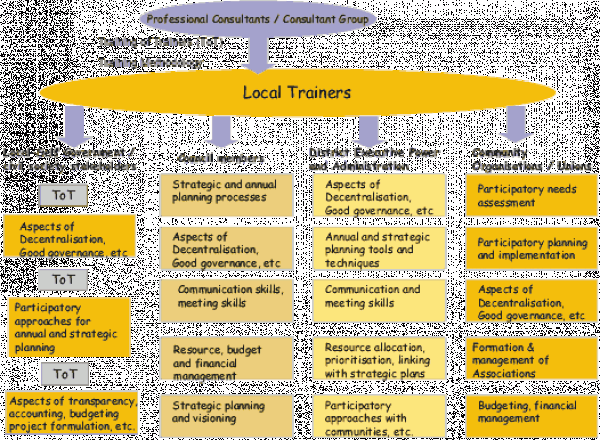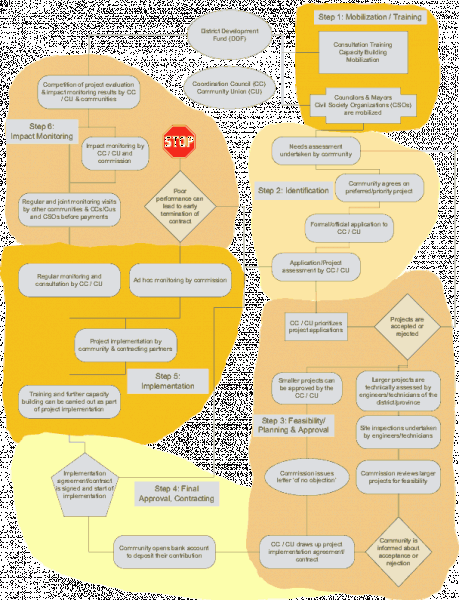|

|
Principle steps for establishing the fund:
- Establish a project fund menu that defines eligibility, procedures, and criteria for acceptance of proposals and conditions for financing.
- Promotion and training.
- Project selection and application.
- Feasibility study and application selection.
- Contracting.
- Provision of the local grant.
- Monitoring of Project Implementation.
- Post Monitoring and Evaluation.
1. Project fund menu: The menu needs to define (i) who is qualified for assistance (eligibility) provided by the fund; (ii) what kind of assistance is available from the fund (type of activities that will be supported and those to be excluded) and, (iii) process for requesting support has is to be submitted.
Establishing specific criteria for accepting project proposals is an important instrument for determining the extent to which a Social Fund will meet its objectives. Depending objectives established for the Social Fund, four general criteria are of particular importance. First, the project should be designed to benefit the poor. Second, the implementing organization should be able to effectively deliver the intended benefits to the target groups. Third, that the project proposed is both technically sound and technologically simple. Fourth, the resulting maintenance costs incurred by the project upon completion can be effectively met by the communities.
Furthermore, it will be necessary to ensure consistency of projects with national and sector priorities in cases where the Social Fund has developmental (rather than merely emergency) objectives.
Other project selection criteria could include: involvement of beneficiary communities in different aspects of project design, implementation, and monitoring; the use of labour-intensive techniques.
Co-financing from the beneficiaries: This is necessary to ensure that projects are responding to demand and that sub-projects will be sustainable after the fund financing has been completed. As a general principle the project-proposing agency or community will be required to make a funding contribution towards the financing of the project (possibly with an exemption for very poor communities). That contribution can be made in cash, kind (materials, land) or labour.
2. Training: to built the capacity of the community that they can articulate their needs and to acquire skills to prepare and manage projects. Depending on local needs, training could cover marketing (choosing the product, pricing, marketing techniques), financial management (bookkeeping, monitoring, calculating profits, valuing stock), and human resource development (organising teams, managing people and activities, interpersonal skills). Training can be very important for ensuring that technically sound projects are forthcoming from local groups and that they are effectively implemented. Intermediary NGOs, where they exist, could be enlisted to perform this function.
Figure 1: Approach for developing training capacity

3. Project selection and application: Before project selection can take place information about the fund in form of a simple brochure or mass media (newspaper, radio, television) must be disseminated to the intended target group. The information provided will define how the beneficiaries can request projects, the selection criteria to be used, and conditions for financing. Projects are to be identified by the final beneficiaries. Selection is to be a joint process between beneficiaries and local or regional authorities to ensure consistency with the overall development planning.
Figure 2: Suggested approach for the communities to access the development fund

4. Feasibility study and application selection:
The application or poposal is evaluated according to the above mentioned criteria:
- The project is designed to benefit the poor.
- The implementing organisation can effectively deliver the intended benefits to the target groups.
- The project is technically sound and technologically simple.
- The estimated budget is appropriate for the type of project proposed
- The maintenance costs implied by the project can be effectively met (sustainability).
- The project is consistent with national and sector priorities in cases where the Social Fund has developmental (rather than merely emergency) objectives.
- Beneficiary communities are involved in project design, implementation, and monitoring.
- Beneficiary communities can make a contribution (in cash or kind) towards project cost
The responsibility for application selection should be allocated to a team rather than an individual. Members of the team should include representatives of the different types of organisations eligible for proposing projects, and individuals who are highly respected for their integrity.
5. Contracting: After project approval, a contract between the parties will be concluded which states the conditions of the grant provision according to regulations of the funding agency and laws of the country. A clear set of implementation rules, accompanied by a public monitoring and auditing system, will protect the fund related spending from corruption. The contract states arrangements for maintenance and includes an operation plan.
6. Provision of the Local Grant: After the contract is signed the grant is provided in number of instalments, depending on the size of the contract. The first instalment is provided after signing the contract, later instalments after submission of respective monitoring reports, and the last instalment is provided after the project is completed and satisfactorily evaluated.
|



